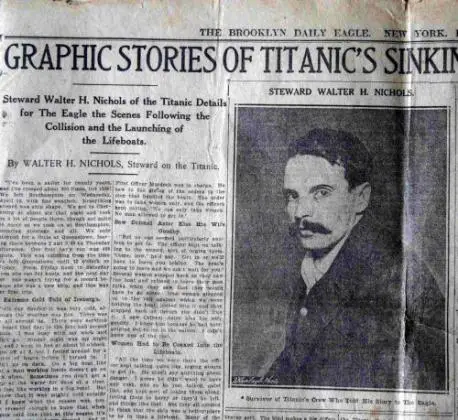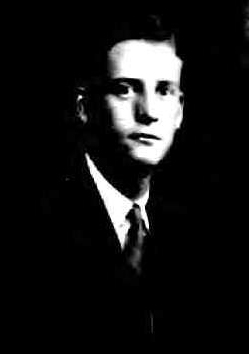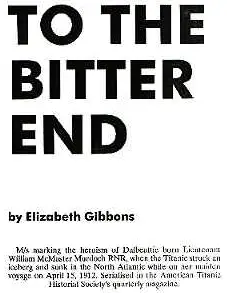23. Gunshots
There had already been a few incidents of sudden panic. Fifth Officer Lowe, in charge of No. 14, had feared that male passengers would leap into the lifeboat as it was being lowered; he fired his Browning automatic horizontally along the ship to prevent what he perceived as a "rush" from lower decks. Lowe described the men first as "Italians", then as "Latin people", then compared them to "wild beasts, ready to spring". He meant foreigners, undisciplined by definition. (Page 417)
Lightoller found a few men trying to hide in another boat, again on the port side. Brandishing a pistol was sufficient here; Lightoller in his memoirs dismissed the men as foreigners from whom courage could not be expected, emphasizing his contempt by adding that he had never bothered to load his gun.
Murdoch had loaded his revolver, and at Collapsible C, he used it. First Class passenger Hugh Woolner had been assisting the loading on the port side, and had just turned away from Collapsible D, remarking to his companion that there was nothing more to do, when he heard shots from the starboard side.
Mr. Woolner: . . . There was a sort of scramble on the starboard side, and I looked around and I saw two flashes of a pistol in the air.
. . . . .
Senator Smith: Pistol shots?
Mr. Woolner: Yes; but they were up in the air, at that sort of an angle [indicating]. I heard Mr. Murdoch shouting out, 'Get out of this, clear out of this,' and that sort of thing, to a lot of men who were swarming into a boat on that side." (Page 886)
There was another witness, First Class passenger John Thayer, Jr., who saw the two shots into the air. (He thought that the lifeboat involved had been one of those loaded from A Deck, but the fact that he saw Ismay enter it indicates that it was No. C on the boatdeck.) Thayer wrote his reminiscences for strictly private use in 1940, and recalled that it was Purser McElroy with the revolver. This is unlikely, as only deck officers were provided weapons, and there is no reason a purser should have brought one in his luggage. However, on at least one other occasion, someone had mistaken Murdoch for McElroy, on the grounds that they were both "tall men". (Page 600)
Thayer was certain there were only two shots, and that no one was hit by them. He jumped near the end, and was one of those who reached collapsible B.
Out on the Atlantic, saloon steward Walter H. Nichols, in lifeboat No. 15, saw "two flashes and heard two revolver reports" coming from somewhere near the bridge; he wondered what they meant. Nichols was sure there were only the two shots. He wrote an account of his experiences to his sister, Mrs. James Openshaw, a disjointed and confusing narrative in which the gunshots figure prominently; Mrs. Openshaw had it published in the New York Times on April 22, 1912.

Steward Walter Nichols account in the Brooklyn Daily Eagle, New York.
In his letter, the steward stated that the officer in charge on the starboard boatdeck had a revolver in his hand and gave his orders so "quietly" (Nichols' word) that the crew even as late as the lowering of Nos. 11, 13 and 15 still did not know that anything was seriously wrong. Nichols' observation that Murdoch was obviously armed by the time No. 11 was ready (approximately 1:25 am - it is possible that Murdoch was armed at No. 9, which puts Haines' testimony that the First Officer merely "looked" at the men waiting in a much altered light) is interesting on two counts: firstly, Nichols thought nothing about it and clearly made no connection between the revolver and the possibility that the Titanic would actually founder, and secondly, it suggests that Murdoch was expecting some sort of disorder. Some 15 minutes later, at Collapsible C, trouble exploded.
Hugh Woolner's companion was Bjornstrom Steffanson, a reserve lieutenant in the Swedish Army and an attache at the Royal Swedish Embassy in Washington. Both had run from the port to the starboard boatdeck upon hearing loud shouting and the unmistakable sounds of a panic, and had arrived in time to see Murdoch firing into the air. Women passengers mostly from Third Class Woolner identified them as "Italians and foreigners" were attempting to board No. C, but were barred by a rush of men, also apparently from Third Class. Woolner and Steffanson shoved their way forward to help Murdoch and his boat crew. It was apparently a major failure of the order so apparent all that night, as Woolner estimated that he and the lieutenant had removed a dozen between them, and that more were thrown out by the crew:
Mr. Woolner: . . . But they were really flying before Mr. Murdock from inside of the boat at the time." (Page 886)
Woolner and Steffanson assisted in loading the women, then as No. C was lowered they crossed the boatdeck, going down to A Deck. As they exited the glass enclosed promenade area onto the open deck toward Titanic's bow the sea washed over their feet. Collapsible D, still being laboriously lowered from the deck above, was suspended some nine feet below, bumping against rivets on its way down. Both men climbed the rail and jumped into a vacant place in the bow.
Steffanson did not testify before the Senate; Woolner did appear, and is a witness of lucid prosaicness. His description of Murdoch during the loading of No. C, combined with Nichols' and Thayer's observations three independent witnesses with no reason to lie eviscerate the stories which began to circulate immediately about what had happened there. The shots which Murdoch fired obviously into the air and probably toward the bow became in rumor shots which killed one or perhaps three persons, depending upon which rumor was preferred. If true, this would give Murdoch single handedly as high a death rate as the OK Corral. But while colorful it was not true.
One lurid story had Murdoch firing directly into the jaw of some unfortunate, purportedly one of the stewards, who was jerked back on deck and rejoined the crowd. It is too persistent a story not to have some element of truth about it. Journalist Philip Gibbs, compiling his Deathless Story, quoted a New York interview with an eyewitness First Class passenger William T. Carter, only ten years old. Master Carter was quoted as follows:
"Once a lot of men got through and there was some shooting, and some of the men fell on the deck, while everyone cried out very loudly. One of the men stood still for some time, and all his jaw was shot away. I was watching him, holding on to mother's skirts, when it came our turn to get into the boat."

Young first class passenger Master
William T Carter.
An intelligent child staring fixedly at something dramatic is a fine witness, but unfortunately Master Carter cannot be here counted as one; he left with his mother in No. 4, lowered from the port side after No. C, and from A Deck and not the boatdeck. No. 4 held most of the famous millionaire names, and those who would leave in it had been waiting to board for a long time indeed. Young William Carter could have seen nothing of the shooting above him. (Even assuming that Mrs. Carter permitted her son to grant interviews, this one seems to have been written by someone with little knowledge of real children, and contains a glaring solecism: no ten year old American boy is going to admit clinging to his mother's skirts.)
Whoever wrote this story, however, may have guessed the actual circumstances behind the stories of death and wounding at No. C; it must be borne in mind that gunfire, riots and the behavior of people facing both were familiar to any experienced New York reporter. Woolner's description of men "flying" before Murdoch explains the firm belief of a number of witnesses of general credibility (Third Class passenger Eugene Daly is one) that men were shot dead. In the semi darkness, in a crowd, in the terror and panic, it would have been difficult to discern whether men being pulled, pitched or thrown out of a lifeboat were passively resisting, unresisting, limp with fear, moving of their own volition, or dead. The shots were, after all, intended to terrify and to intimidate, and they did. It would not be difficult, either, to infer a gunshot wound from seeing a man stunned and bleeding from injuries incurred when struck on the jaw by a very angry William Murdoch, swinging a fist with a gun in it. Anyone who believes that a man can be shot at close range and then either stand "still for some time" or otherwise resume a place in a crowd is invited to hang around the emergency entrance of any big city American hospital on a Saturday night and see for himself.
Most pre World War I pistols weighed around two and one half pounds, and required anything between eight and twelve pounds of pressure on the trigger for double action firing. (Single action guns are useless in an emergency; five pounds or less of "pull" is a hair trigger.) That Murdoch fired in the air twice, the second shot following immediately, indicates that the pistol was double action. He could not, therefore, have accidentally shot anyone it would have had to have been a deliberate act. As both shots fired were seen as well as heard, there is therefore little probability of firing into the crowd; a third shot, of course, would have been noted by Woolner, Nichols and Thayer.
The most curious if not generally noted feature is the testimony on this point by Colonel Gracie. Gracie, either because of or in spite of his Army background, was strikingly oblivious to gunfire. Although present in the bridge area, usually assisting Lightoller, Gracie personally remembered no shots. Nevertheless, he told Senator Smith, who happened to be a friend and neighbor, that it was Lightoller who had fired them; information given to him, he said, by the Second Officer himself. (Page 991)
Lightoller had threatened men on the port side with his revolver, ordering them to vacate a lifeboat or be shot. He had, however, not even loaded his revolver, relying solely on bluff. His only reason for convincing Gracie to repeat this story would be to protect Murdoch's posthumous reputation. He could not know what had happened that night while No. C was readied, but he could contradict the stories that reached him on the Carpathia by inventing one of his own. It was a noble if unnecessary and undersubtle maneuver.
Interestingly, if Murdoch had killed a man, the British and American press, and presumably their readers, would not have particularly cared. In all the irate editorials written to excoriate the slackness of White Star, the failings of government supervision, and the malfeasance of corporations, protests against allegedly shooting justifiably frightened people do not appear. The fear is despised, and the fearful assumed to be lesser breeds, beyond compassion. In the American press, even as far west as the Sacramento (California) Bee, everyone whose courage was reported to have failed seemed to be "Italian".
Able seaman Harry Thompson in his interview with Philip Gibbs gives a chilling example of this combination of contempt and gunfire. Thompson claimed that he had been near a forward companion ladder designed to give Third Class emergency access to the boatdeck; he claimed he heard steerage passengers "fighting" to reach the ladder. Murdoch arrived and, according to Thompson, drew his gun and shouted for men to stand aside and let the women ascend, adding: "I'll kill the first man up"; three men who thought he was bluffing, Thompson claimed, came up ahead of women and were promptly shot dead. As Thompson was already off the Titanic in No. 9 before Murdoch fired his revolver he could have seen nothing of the sort, and obviously combined stories of the shooting at No. C with what might have been an actual incident and very real threat earlier in the night (or may not have been a real incident -the location of such a ladder is problematical).
Thompson's version made a much more dramatic tale, of course, and possibly one he himself needed to believe: Thompson admired Murdoch, telling Gibbs that the First Officer was the "real hero" of that night. The editor of the Kirkcudbrightshire Advertizer on April 26, 1912, printed a variation of Thompson's description of Murdoch stopping a rush from Third Class:
"It was he who met the frightened crowd of emigrants at the head of the steerage ladder, and quelled the incipient disorder."
No guns appear in this version; merely a report that might have come from anywhere in the Empire in that time, that of a mob faced down by a solitary British officer. Like Thompson, the editor was impressed, but unsurprised.
In 1912, "foreigners" were by definition incapable of the heroism expected of Anglo Saxons and Teutons; both nouns, used interchangeably and laudatorily, appear unselfconsciously in the narratives of some commentators describing the passengers that night. Beesley would credit the restrained and obedient behavior of passengers (meaning First and Second Class principally) to the inherent characteristics of the "Teutonic race", and everyone knew what he meant. On August 3, 1914, the bottom would drop out of the Germanic hero market, but in 1912 the concept was held in deadly earnest; it was an idea on which lives and reputations could depend.
The equation of courage with race on the Titanic would have one curious revival in the future. Many motion pictures would be made about the sinking, but in 1944 the German film industry made a feature length film with a difference; Lightoller in the Nazi version was transformed into a German officer, heroically endeavoring to bring order out of the chaos of an all British disaster. This singular interpretation ended in the safe-keeping of the United States Alien Property Custodian, where, apparently, it remains. I am indebted to Walter Lord -- who has seen the movie -- for this absolutely delightful story.
